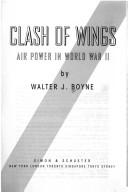Check nearby libraries
Buy this book

Clash of Wings is the first popularly written, comprehensive account of the role of air power over land and sea in World War II. Col. Walter J. Boyne, USAF (Ret.), brings extensive experience and an expert knowledge to this lively history.
World War II was the first major war in history in which air power played a decisive role. Yet even today, fifty years after the events, there is still some disagreement about the lessons of the war. In this analysis of the major air powers, Col. Boyne offers some fascinating and surprising conclusions:. Air superiority in Europe was not won until American bombers were used as bait to lure the German fighters up to be destroyed.
The Soviet Union's Air Force has been terribly underrated; its key role in turning back the Nazi invasion is still not fully appreciated. The Japanese Air Force, while initially superb in equipment and training, was too small to engage in a world war; its initial successes derived from British and American unpreparedness. Later, the Japanese were reduced to futile, suicidal kamikaze tactics. The Germans did not realize the huge number of aircraft they needed until it was too late.
The Allies were slow to use air power effectively, but when they did, they changed the course of the war. The Axis powers never altered their fundamental strategies, even as those strategies failed.
Boyne carefully analyzes the important technological breakthroughs, such as radar, which gave the RAF the decisive advantage in the Battle of Britain, and the jet plane, which came too late to save Germany. He sheds new light on the controversies over the strategic bombing of Germany and Japan and the dropping of the atomic bombs on Hiroshima and Nagasaki.
Clash of Wings also profiles the important, often colorful figures who directed the major air campaigns, among them Generals Arnold, Spaatz, LeMay, and Doolittle in the U.S.; Air Marshals Dowding and Harris in Britain; Reichsmarschall Goring and Generalleutnant Adolf Galland in Germany; Admiral Yamamoto in Japan; and General Balbo in Italy.
Boyne discusses the principal air campaigns, including the invasions of Poland and Western Europe, the long hard fights in the desert, the mammoth campaign in Russia, and the day and night bombing campaigns, as well as the violent carrier battles that transformed war at sea from Pearl Harbor to Okinawa and beyond. In the process he applies his vast knowledge to critically evaluate all of the famous planes, both fighters and bombers, that made history, among them the Spitfire, Mustang, Hellcat, Fortress, Liberator, Messerschmitt, Thunderbolt, Zero, Shturmovik, and the B-29.
He also analyzes lesser-known planes as well, including the Gladiator, Falco, Helldiver, Owl, and Oscar. Authoritatively researched and vividly written, Clash of Wings is a fresh, comprehensive look at pivotal events of World War II in the air.
Check nearby libraries
Buy this book

Previews available in: English
Showing 2 featured editions. View all 2 editions?
| Edition | Availability |
|---|---|
|
1
CLASH OF WINGS: World War II in the Air
June 6, 1997, Simon & Schuster
Paperback
in English
0684839156 9780684839158
|
zzzz
Libraries near you:
WorldCat
|
|
2
Clash of wings: air power in World War II
1994, Simon & Schuster
in English
0671793705 9780671793708
|
aaaa
Libraries near you:
WorldCat
|
Book Details
Edition Notes
Includes bibliographical references (p. [393]-395) and index.
Classifications
The Physical Object
ID Numbers
Source records
marc_openlibraries_sanfranciscopubliclibrary MARC recordLibrary of Congress MARC record
Better World Books record
marc_columbia MARC record
First Sentence
"World War II began in the air at exactly 0434 hours, September 1, 1939, when three German Stuka dive-bombers burst through murky weather attack two railroad bridges spanning the Vistula River near Dirschau, Poland."
Community Reviews (0)
Feedback?| July 25, 2024 | Edited by MARC Bot | import existing book |
| October 5, 2021 | Edited by ImportBot | import existing book |
| February 28, 2020 | Edited by MARC Bot | remove fake subjects |
| July 14, 2017 | Edited by Mek | adding subject: Internet Archive Wishlist |
| December 9, 2009 | Created by WorkBot | add works page |













